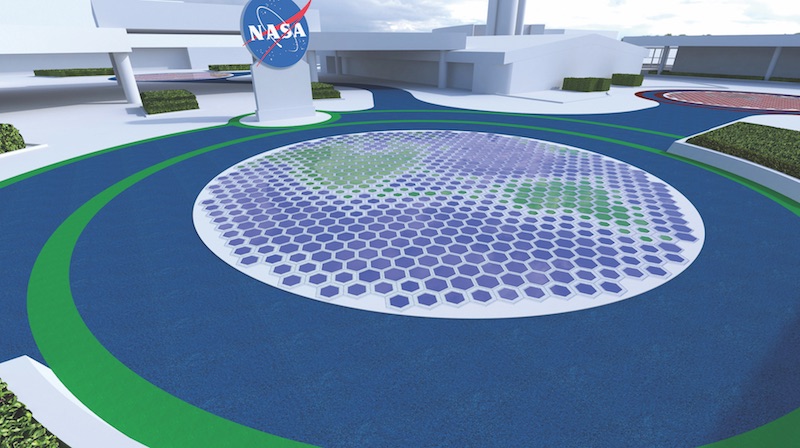Piezoelectricity, an electrical charge that aggregates in certain materials in response to applied mechanical stress, was discovered in the 19th century. In recent times, the technology has found its way into electronic devices and medical sensors. There’s growing interest in using the technology to generate energy from roadway traffic (see related story).
PZ technology is also being studied for its potential for harvesting and redistributing energy in buildings.
The Aerospace Transportation and Advanced Science Lab at Georgia Tech Research Institute (GTRI), Atlanta, is investigating indoor applications of PZ technology, not only as an alternative energy source but also for making buildings smarter by transmitting data wirelessly for analyzing behavior and traffic.
GTRI is working with Emory Healthcare to develop a PZ-powered carpet tile for a flooring system for hospitals that would detect when a patient slips and falls and send out a wireless alert to hospital staff. Every year in U.S. hospitals, between 700,000 and 1 million people have a fall: it’s a tremendous liability headache for hospital administrators. This project, says GTRI Research Scientist Ilan Stern, PhD, is in the prototype/focus-group stage. GTRI is building a lab-scale model into its simulation lab.
 Dr. Ilan Stern of the Georgia Tech Research Institute stands inside a photo booth at Atlanta’s Hartsfield-Jackson International Airport. The booth is activated by electricity generated by foot traffic on the floor mat made from piezoelectric materials. Stern foresees this technology being used for crowd control and security purposes. Courtesy Georgia Tech Research Institute.
Dr. Ilan Stern of the Georgia Tech Research Institute stands inside a photo booth at Atlanta’s Hartsfield-Jackson International Airport. The booth is activated by electricity generated by foot traffic on the floor mat made from piezoelectric materials. Stern foresees this technology being used for crowd control and security purposes. Courtesy Georgia Tech Research Institute.
GTRI also has a contract through the Delaware North Corporation to install 40,000 sf of PZ-enabled pavers along the Visitors Center at NASA's Kennedy Space Center in Florida. Stern explains that the pavers—designed by Dr. Francisco Valdes and Paula Gomez and manufactured by Formations Studio—have glass inserts that act as a kind of interactive keyboard; when energized, the system allows visitors to see visualizations of NASA’s mission statements for space exploration, energy and sustainability, education and wildlife. Stern says it will be operational by next August.
GTRI recently received a $100,000 grant authorized by the Wells Fargo Foundation to evaluate how PZ technology might improve bank security. “The PZ sensors are built into the flooring system, which would act as a tracking and monitoring device to identify where there are people walking in restricted areas,” says Stern. The piezoelectric system would keep working even if power to the bank were cut off.
For the past year or so, passengers and visitors at Atlanta’s Hartsfield-Jackson International Airport have been getting their pictures taken in a photo booth energized by foot traffic. When the booth reaches a certain level of PZ, a camera is triggered, snapping a shot that can be uploaded to social media. Stern sees the day when airports will use PZ-enabled pads and flooring for crowd management and security.
Stern acknowledges that applications for federal grants for PZ research under the new administration will have to be rebranded from their past emphasis on efficiency and sustainability. “While we’re not changing our research, we’re changing our goals to infrastructure and manufacturing,” he says.
Related Stories
Codes and Standards | Apr 12, 2024
ICC eliminates building electrification provisions from 2024 update
The International Code Council stripped out provisions from the 2024 update to the International Energy Conservation Code (IECC) that would have included beefed up circuitry for hooking up electric appliances and car chargers.
Sustainability | Mar 29, 2024
Demystifying carbon offsets vs direct reductions
Chris Forney, Principal, Brightworks Sustainability, and Rob Atkinson, Senior Project Manager, IA Interior Architects, share the misconceptions about carbon offsets and identify opportunities for realizing a carbon-neutral building portfolio.
Green | Mar 25, 2024
Zero-carbon multifamily development designed for transactive energy
Living EmPower House, which is set to be the first zero-carbon, replicable, and equitable multifamily development designed for transactive energy, recently was awarded a $9 million Next EPIC Grant Construction Loan from the State of California.
Sustainability | Mar 21, 2024
World’s first TRUE-certified building project completed in California
GENESIS Marina, an expansive laboratory and office campus in Brisbane, Calif., is the world’s first Total Resource Use and Efficiency (TRUE)-certified construction endeavor. The certification recognizes projects that achieve outstanding levels of resource efficiency through waste reduction, reuse, and recycling practices.
Legislation | Mar 21, 2024
Bill would mandate solar panels on public buildings in New York City
A recently introduced bill in the New York City Council would mandate solar panel installations on the roofs of all city-owned buildings. The legislation would require 100 MW of solar photovoltaic systems be installed on public buildings by the end of 2025.
Green | Mar 5, 2024
New York City’s Green Economy Action Plan aims for building decarbonization
New York City’s recently revealed Green Economy Action Plan includes the goals of the decarbonization of buildings and developing a renewable energy system. The ambitious plan includes enabling low-carbon alternatives in the transportation sector and boosting green industries, aiming to create more than 12,000 green economy apprenticeships by 2040.
Sustainability | Feb 26, 2024
GBBN's Inflation Reduction Act Calculator goes live
GBBN has publicly released its IRA Calculator, a tool that helps you understand funding opportunities in the IRA for sustainable design.
MFPRO+ News | Feb 15, 2024
Nine states pledge to transition to heat pumps for residential HVAC and water heating
Nine states have signed a joint agreement to accelerate the transition to residential building electrification by significantly expanding heat pump sales to meet heating, cooling, and water heating demand. The Memorandum of Understanding was signed by directors of environmental agencies from California, Colorado, Maine, Maryland, Massachusetts, New Jersey, New York, Oregon, and Rhode Island.
Codes | Feb 9, 2024
Illinois releases stretch energy code for building construction
Illinois is the latest jurisdiction to release a stretch energy code that provides standards for communities to mandate more efficient building construction. St. Louis, Mo., and a few states, including California, Colorado, and Massachusetts, currently have stretch codes in place.
Sustainability | Feb 7, 2024
9 states pledge to accelerate transition to clean residential buildings
States from coast to coast have signed a joint agreement to accelerate the transition to pollution-free residential buildings by significantly expanding heat pump sales to meet heating, cooling, and water heating demand in coming years.

















